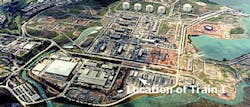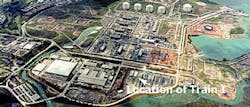Simulating the effectiveness of different design options can optimize investment and appraise reliability of a grassroots project or plant expansion. TotalFinaElf SA has developed a specific methodology that evaluates effectiveness for any sizeable investment.
This article summarizes the approach as applied to an expansion of the Bontang LNG plant. Overall plant effectiveness can be defined as: Plant effectiveness = sum for all process trains (availability of each LNG train x potential production of the train). As used here, effectiveness is the plant's composite availability with a focus on its output potential.
This state-of-the-art methodology offers a realistic approach to evaluate the performance of a given plant configuration and its sparing philosophy based on:
- A fair representation of the relation ships between plant output and the status of its various units.
- A simulation of these relationships.
- Actual historical data of unscheduled shutdowns and of preventive maintenance for future scheduled shutdowns.
In past projects, each new process unit was designed with a fixed number of utility packages irrespective of spare capacities and the plant's target availability.
Effectiveness studies have replaced the old concept of additive spare units by using an integrated optimized approach for complex systems such as refineries or LNG plants. The potential for cost reduction expected from an effectiveness simulation increases with plant size and complexity. An effectiveness study conducted by TotalFinaElf identified cost savings of more than $40 million for the Bontang LNG plant expansion.
Background
TotalFinaElf E&P Indonesie supplies about 65% of the feed gas to Pertamina's Bontang LNG plant, the world's largest with a capacity of 22.25 million tonnes/ year (tpy) that accounts for about 25% of the Asian LNG market. Pertamina, TotalFinaElf, and Unocal Inc. are contemplating an expansion of the Bontang LNG plant (Train-I) further to monetize large uncommitted gas reserves.
Competition in LNG trade directed the Train-I project team to reduce investment cost and to take a "fit for purpose" approach. An effectiveness study was performed to evaluate the potential cost reduction for the utility facilities.
The Bontang LNG plant has many boilers and power generators with complex interactions. The effectiveness study also took advantage of the extensive historical database of operating data to generate accurate predictions.
Study objectives
The effectiveness study was initiated as part of the objective to optimize Train-I integration with the eight existing LNG trains. The Train-I design, with in the owner's requirements, should have a minimum availability of 95% while maintaining the efficiency, operability, safety, and environmental standards of the existing plant.
The study had three main objectives:
- Accurately appraise the utility systems' capabilities.
- Define the best configuration(s) for Train-I:
- Standalone case: pre-project base case.
- Modular case: Train-I integrated with Module 2.
- Integrated case: integrated steam and electricity for nine trains.
- Mixed case: modular steam and integrated electricity for nine trains.
- Determine the optimum number of additional utility packages for various configurations aiming for: availability of 95% for Train-I and current levels for the other eight trains.
Plant description
The Bontang LNG facilities consist of the existing LNG trains, supporting utilities, and the future Train-I facilities.
Existing trains
The existing Bontang LNG plant consists of eight steam turbine driven, water-cooled liquefaction trains that use the Air Products and Chemicals Inc. propane precooled-MR process. The first two trains started in 1977 and the eighth train was commissioned in 1999.
The existing trains have been upgraded and debottlenecked since their commissioning.
Gas produced in different fields in East Kalimantan, Indonesia, moves to the plant through four pipelines.
LNG and LPG products are exported to Japan, Korea, and Taiwan, while the condensate is returned to Unocal facilities in Santan, Indonesia.
Supporting utilities
Two modules provide utilities to the existing eight trains (Fig. 1):
- Module I (11 boilers and 6 generators) supports Trains A to D.
- Module II (10 boilers and 7 generators) provides utilities to Trains E to H.
The two steam modules currently operate independently. The power system operates in an integrated mode while the power generation and distribution system can operate in modular mode. In the integrated mode, steam and power generation have extra available capacities.
The project scope included:
- A new process train (Train-I) complete with gas purification, fractionation, refrigeration, and liquefaction units.
- Extending or interconnecting the new process train to the existing utilities and off sites facilities.
Pre-project studies based on simple package availability calculations (the old concept of spare units) concluded that three boilers and two power generators were required for the new Train-I.
Effectiveness study methodology
The effectiveness study was developed with TotalFinaElf internal standards according to four steps (Fig. 2).
Step 1 provides a detailed understanding of the plant's operating modes with a list of the probable causes of production loss. Step 2 builds the mathematical effectiveness model. Step 3 selects the reliability data and a specific software package performs the effectiveness calculation. Step 4 provides calculation results with conclusions and recommendations.
Step 1: System analysis
The plant operating modes were thoroughly analyzed starting with engineering documentation such as process flow diagrams (PFDs) and with the advice of PT Badak engineers. Functional diagrams showed the analysis results.
The consequences of each unit failing (LNG trains, cooling water pumps, steam boilers, and power generators) were then analyzed and documented with failure mode and effects analysis (FMEA) cards.
Step 2: Effectiveness modeling
A mathematical model evaluated plant effectiveness.
A specific modeling technique, "Petri Nets," was used.1 2 A Petri Net is a mathematical representation of all possible links between item states (e.g., steam boiler shutdown) and possible plant conditions (e.g., 100% production rate).
Transitions between each item state are governed by statistical laws such as the exponential law for modeling the probability that an item will fail-e.g., to move from the "steam boiler up" state to the "steam boiler down" state.
Step 3: Quantitative analysis
The failure rate and restoration rate for each piece of equipment was extracted from plant historical records. PT Badak provided the impact of each equipment failure on LNG production. While collecting reliability data, we identified and quantified several common causes of failure using historical records.
Provisional data for planning future maintenance, as specified by the operating company, were used instead of historical records to assess the impact on plant effectiveness.
Due to the large number of items to be considered and the necessity to synchronize them, a software package (MOCA-RP) was used to model the "Petri Nets." We performed 1,000 simulations over a 10-year operating period to provide meaningful results. We analyzed 16 cases to identify the optimum number of additional utility packages for various module configurations.
Step 4: Synthesis
Step 4 formulated conclusions and recommendations based on the post-processing of the MOCA-RP outputs.
Reliability data
Table 1 shows the reliability data used in the calculations. They include shutdowns for preventive maintenance (PM).
Failures from 1990 to mid-2000 were analyzed to provide the mean time between failures (MTBF) and common-cause MTBF. Time spans between failures were deduced from machinery running hours and the number of failures was deduced from trips records.
Mean-time-to-restore (MTTR) calculations were based on the records of 1998-2000. Table 2 shows the values of common-cause failures. Table 3 shows MTBF and MTTR, excluding the effects of preventive maintenance.
Preventive maintenance
Provisional data in Table 4 were used for future planned maintenance to assess the impact on plant effectiveness.
Study results
To meet a minimum effectiveness of 95% for Train-I while maintaining Trains A to H at their present effectiveness, the simulations showed that:
- It is not necessary to add a new power generator with integrated or modular power.
- Two additional boilers are mandatory with modular steam.
- One additional boiler is mandatory with integrated steam.
In all integrated mode cases:
- One additional boiler has a significant impact (+2.47%) on Train-I effectiveness and is mandatory.
- One additional power generator has a negligible impact (+0.08%) on Train-I effectiveness.
In all modular mode cases:
- The second additional boiler has a significant impact (+3.45 %) on Train-I effectiveness and is mandatory.
- One additional power generator has a smaller impact (+0.82 %) on Train-I effectiveness.
In the integrated power and modular steam case, a second additional boiler is mandatory to meet 95% minimum effectiveness for Train-I.
Cost estimates
Table 5 shows the estimated cost differentials.
Although the case with both modules fully integrated and a single boiler met the project requirements, the fully integrated alternate with two boilers and no generator was used as the base case.
This option is $40 million cheaper than the pre-project case, leading to a gain in investment equivalent to about 8% of the estimated contract price.
The recommendations included a detailed investigation of the steam and power systems. The studies concluded that the integrated steam configuration was feasible and safe to operate.
Detailed electrical studies showed that an additional generator would be required if the power was operated in modular mode to keep a workable voltage spread for all operating scenarios.
Acknowledgment
The authors thank Pertamina, TotalFinaElf E&P Indonesie, Unocal Inc., and PT Badak management for their support.
References
- Leroy, A., and Signoret, J.-P., "Proba bilistic calculations of the production of a subsea production cluster," presented at Achievement of reliability in operating plant symposium, Southport, UK, 1985.
- Cordier, C., Fayot, M., Leroy, A., and Petit, A., "Integration of process simulations in availability studies," Reliability Engineering and System Safety, 1997.
The authors
Michel Fayot is currently Maintenance Expert at TotalFinaElf, Paris. Previously, he was maintenance manager at Total Indonesie, Balikpapan, Indonesia.
Georges Raimondeau is the Train-I project manager (advisor) for TotalFinaElf, Jakarta, Indonesia. He was previously manager operations (upsteam and downstream) of Qatargas, Doha, Qatar, from 1995 to 2000, and occupied various management positions for Total E&P worldwide after joining the group in 1980. He started his career with Exxon Refining, Marseilles, France, in 1971.
Chris Thomas is an engineering manager (advisor) for the Bontang LNG Train-I project, Jakarta, Indonesia. Previously he was in charge of gas technology within the Business Development division of TotalFinaElf E&P, Paris, France, and was responsible for the start-up of Qatargas LNG Trains 1 and 2, Doha, Qatar.
Nanang Untung is the Pertamina project engineer for the Bontang LNG Train-I project Jakarta, Indonesia. He worked for Arun LNG Plant, Aceh, Indonesia, for 14 years before joining Pertamina in 1996. His major project experiences include: technical coordinator of the North Sumatra Offshore Project, LNG facilities engineer for the Natuna Project Jakarta, Indonesia, and process engineering superintendent of the Bontang LNG Train H.
Alain Leroy is the founder of Fractal Systeme, Paris, France, a consulting firm specialized in risk analysis with a dedicated expertise in the oil and gas industry. He also co-developed MOCA-RP. ([email protected])










